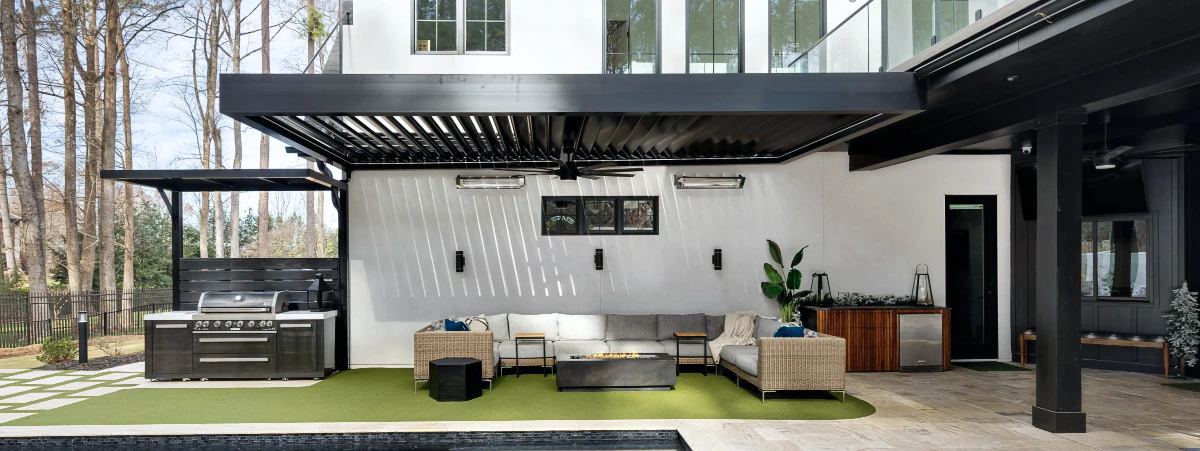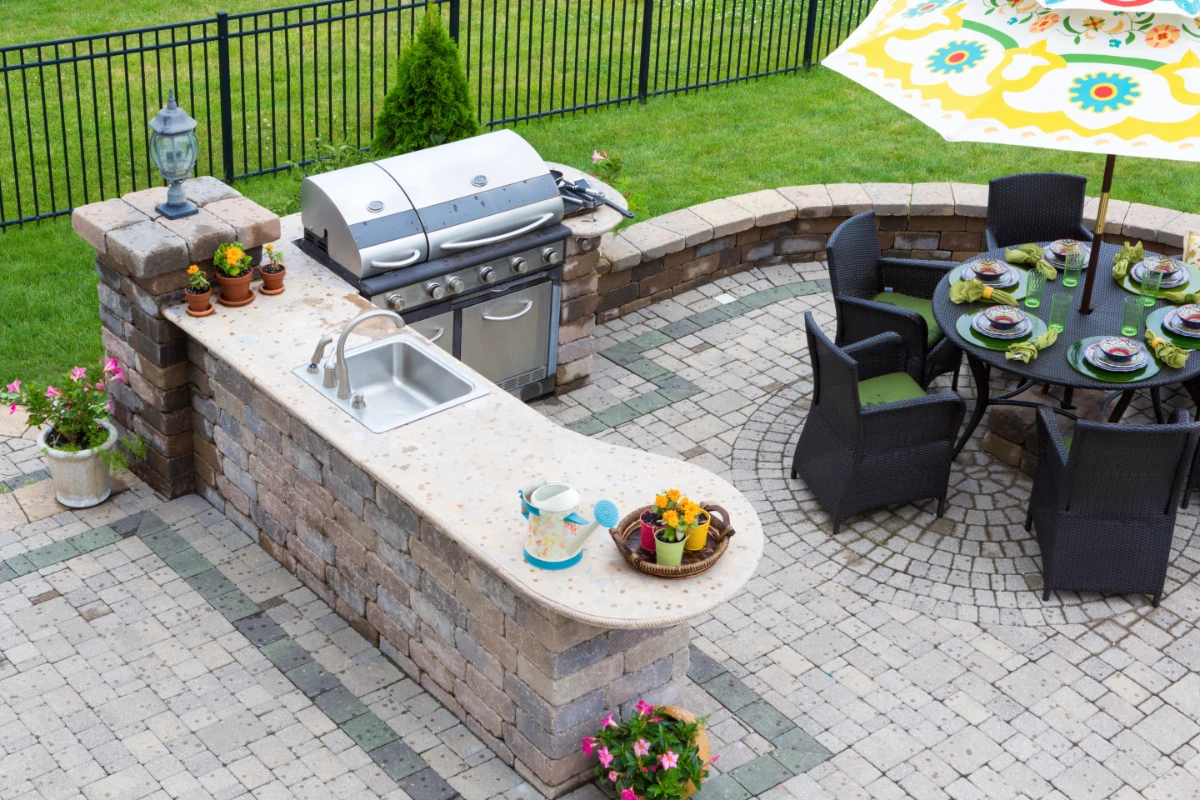Building an outdoor kitchen can transform your backyard into an entertaining paradise. Whether you’re a seasoned chef or a casual cook, an outdoor kitchen enhances your culinary experience. This guide provides tips to help you design and build an outdoor kitchen that suits your lifestyle and budget. With careful planning and the right choices, your outdoor kitchen can become a hub for social gatherings and family fun.

Planning Your Outdoor Kitchen
Before diving into construction, planning is essential. Start by determining your budget. This will guide your choices in materials, appliances, and overall design. Think about how you will use the space. Will you host large gatherings or intimate family dinners? Your cooking style and entertaining needs will influence your kitchen’s layout and features.
Consider the style and theme you want for your outdoor kitchen. Do you prefer a modern look with sleek lines and stainless steel, or a rustic style with natural stone and wood elements? Your choice will affect the type of materials and finishes you select.
Also, plan for the future. If you envision your family growing or anticipate hosting larger events, design your kitchen to accommodate these changes. Including extra counter space, larger seating areas, and additional storage can make your outdoor kitchen more versatile and functional in the long run.
Choosing the Right Location
The location of your outdoor kitchen can impact its functionality and enjoyment. Choose a spot close to your indoor kitchen to minimize the hassle of transporting food and utensils. Consider the wind direction to avoid smoke blowing towards seating areas. Ensure there’s enough shade to keep the area comfortable during hot days. Proximity to utilities like water, gas, and electricity is also crucial for convenience and safety.
Evaluate the natural elements of your yard when choosing the location. Look for a flat area to avoid complicated construction. Take into account the view from your kitchen. You might want to position it to take advantage of scenic vistas or to face the pool or garden.
Think about the flow of traffic in your yard. Your outdoor kitchen should be easily accessible without obstructing pathways or recreational areas. If you have a pool, playground, or garden, ensure that the kitchen complements these features without interfering with their use.
Selecting Appliances and Fixtures
Investing in quality appliances is key to a successful outdoor kitchen. Common choices include grills, refrigerators, sinks, and pizza ovens. Choose stainless steel appliances for durability and easy maintenance. Make sure the appliances you select are designed for outdoor use to withstand weather conditions. Consider adding storage cabinets and countertops made from weather-resistant materials like granite or concrete.
When selecting appliances, think about how you will use your outdoor kitchen. If you love grilling, a high-quality grill is a must. For pizza enthusiasts, a wood-fired pizza oven can be a fantastic addition. A refrigerator is essential for keeping drinks and perishable items cool.
Don’t forget about smaller appliances that can enhance your outdoor cooking experience. A built-in ice maker, beverage center, or even a smoker can add versatility to your kitchen. Consider your cooking habits and choose appliances that match your needs.

Designing for Functionality and Comfort
Your outdoor kitchen should be as functional and comfortable as your indoor kitchen. Arrange appliances and workstations to create an efficient workflow. Include ample counter space for food preparation and serving. Provide comfortable seating options for guests, such as bar stools or a dining table with chairs. Incorporate lighting to enhance visibility for nighttime cooking and entertaining. Adding elements like a pergola or retractable awning can provide shade and shelter from the elements.
Think about the layout of your kitchen in zones: cooking, preparation, serving, and dining. Keep these zones distinct yet connected to create an efficient and enjoyable cooking experience. Ensure there’s plenty of counter space around your grill or cooktop for preparing ingredients and plating dishes.
Comfortable seating is crucial for creating a welcoming atmosphere. Consider a mix of seating options, including bar stools for casual dining, a dining table for more formal meals, and lounge chairs for relaxing. Arrange seating to encourage conversation and interaction.
Incorporate elements that enhance comfort and usability, such as fans, heaters, and bug repellents. These additions can make your outdoor kitchen usable year-round and more enjoyable for you and your guests.
Maintenance and Upkeep
An outdoor kitchen requires regular maintenance to keep it in top condition. Clean appliances and surfaces after each use to prevent stains and rust. Cover appliances and furniture when not in use to protect them from the elements. Regularly check gas lines and electrical connections for safety. Consider using outdoor-specific cleaners and sealers to prolong the life of your kitchen components.
Establish a routine for deep cleaning your outdoor kitchen. Periodically clean grills, refrigerators, and sinks thoroughly. Use a stainless steel cleaner to maintain the shine of your appliances. For countertops, use appropriate cleaners to prevent damage and keep surfaces looking new.
Inspect your kitchen regularly for any signs of wear or damage. Check for loose screws, rust, or cracks in countertops and fix them promptly. Regular maintenance can prevent minor issues from becoming major problems.
Consider seasonal maintenance tasks. Before winter, winterize your kitchen by draining water lines and covering appliances. In spring, do a thorough inspection and cleaning to prepare for the cooking season.
Frequently Asked Questions
1. What materials are best for outdoor kitchen countertops? Granite, concrete, and stainless steel are popular choices for outdoor kitchen countertops. These materials are durable, weather-resistant, and easy to clean. They can withstand the elements and maintain their appearance over time. Tile and stone can also be used but may require more maintenance to prevent cracking and staining.
2. How can I protect my outdoor kitchen during winter? To protect your outdoor kitchen during winter, start by cleaning and covering appliances and furniture. Disconnect and store any removable components like propane tanks or hoses. Use weatherproof covers for grills, refrigerators, and sinks. Consider using a tarp or custom cover for the entire kitchen area if possible. Winterizing your kitchen can prevent damage from freezing temperatures and moisture.
3. Do I need a permit to build an outdoor kitchen? Permit requirements vary by location. Check with your local building department to determine if you need a permit for your outdoor kitchen. Generally, if your kitchen involves electrical, gas, or plumbing work, a permit will be required to ensure safety and compliance with local codes. Even if permits are not required, it’s a good idea to consult with a professional to ensure your kitchen is built to code.